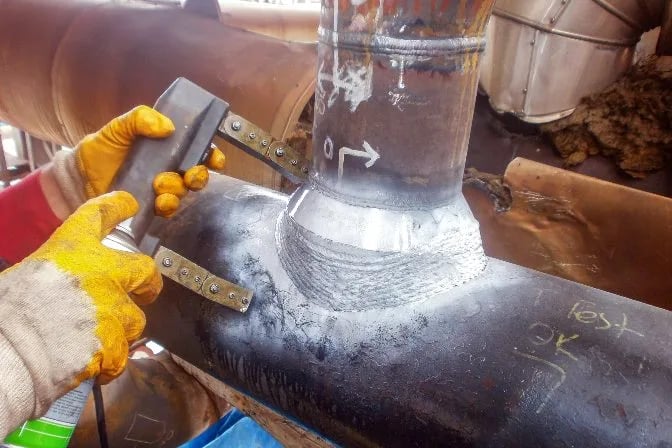Comprehensive Summary of Pipe Welding Assessment Procedures
Pipe welding evaluation treatments play a critical function in guaranteeing that welded links meet strict sector requirements and specs. From meticulous pre-welding inspections to detailed post-weld assessments, a distinct inspection procedure is crucial for keeping the structural sturdiness of pipes.
Pre-welding Inspection Preparations
Prior to commencing the welding process, thorough pre-welding assessment prep work are important to make sure the integrity and quality of the weld joint. These preparations include a careful assessment of the products to be welded, the welding devices, and the workplace. Firstly, the products need to be examined for any issues, pollutants, or variances that could jeopardize the weld. This consists of checking for appropriate material grades, measurements, and surface conditions. Pipeline Welding Inspection. Furthermore, the welding tools needs to be inspected to verify that it remains in excellent functioning problem, calibrated appropriately, and appropriate for the details welding procedure. Any problems with the devices must be dealt with without delay to avoid defects in the weld. Finally, the workplace have to be evaluated for sanitation, appropriate air flow, and precaution to make sure a helpful setup for the welding procedure. By performing thorough pre-welding assessment prep work, possible issues can be identified and settled early on, resulting in trustworthy and high-grade weld joints.
Welding Procedure Certification
Thorough pre-welding assessment preparations lay the foundation for the crucial process of Welding Procedure Qualification, making sure the stability and top quality of the weld joint. Welding Treatment Qualification (WPQ) is an important action in the welding procedure that entails testing and licensing welding procedures to guarantee they satisfy certain standards and demands. The WPQ process usually consists of welding procedure requirements growth, welding treatment qualification testing, and documents of the results.
Throughout welding treatment requirements development, necessary information such as the welding procedure, welding products, joint layout, and welding parameters are defined to create a thorough procedure. Consequently, welding procedure certification testing is conducted to verify the suggested treatment's stability. This screening often includes welding test promo codes that undergo different mechanical and non-destructive tests to examine the weld's high quality and adherence to the defined requirements.
In-process Weld Inspection
Throughout the welding procedure, in-process weld examination plays an important duty in guaranteeing the top quality and honesty of the weld joint - Pipeline Welding Inspection. This kind of inspection involves keeping an eye on the welding parameters, assessing the weld grain formation, and spotting any type of prospective defects or interruptions as they occur. By carrying out in-process weld inspections, welding drivers can promptly resolve any kind of concerns that might emerge, thereby ensuring and protecting against additional defects that the final weld fulfills the needed specs
Typical techniques utilized for in-process weld assessment consist of visual examination, liquid penetrant screening, magnetic particle screening, ultrasonic testing, and radiographic screening. In general, in-process weld evaluation is crucial for keeping the quality and reliability of bonded pipes.
Non-destructive Testing (NDT)
Non-destructive Testing (NDT) is a vital approach employed in pipe welding examination to examine the stability of weld joints without creating damage to the welded framework. By using various NDT methods, assessors can assess the quality of welds and identify any problems or interruptions that might endanger the architectural soundness of the pipeline. Typical NDT techniques utilized in pipeline welding inspection consist of Radiographic Testing (RT), Ultrasonic Testing (UT), Magnetic Particle Checking (MPT), Liquid Penetrant Testing (LPT), and Visual Testing (VT)
RT involves making use of X-rays or gamma rays to create images of the interior framework of the weld, allowing assessors to detect defects such as porosity, fractures, or insufficient combination. UT makes use of high-frequency acoustic waves to spot problems he has a good point under the surface of the weld, offering in-depth info concerning the size and area of issues. MPT and LPT are utilized to determine surface-breaking problems by applying magnetic fragments or penetrant fluids to the weld location. Additionally, VT entails visual examination of welds to recognize any visible flaws.
Post-weld Assessment and Documents


Paperwork of post-weld evaluation findings is important for preserving quality assurance records and making certain conformity with market standards and guidelines. Thorough records should consist of info concerning the examination methods utilized, the place and nature of any type of issues this page discovered, and any type of rehabilitative activities taken - Pipeline Welding Inspection. Correct documentation not only works as a document of the weld's top quality but also help in future upkeep and evaluation procedures
Conclusion

In verdict, pipe welding examination treatments play a crucial function in ensuring the high quality and integrity of welds. Generally, adherence to correct inspection procedures is key to the success of pipeline welding projects.
From precise pre-welding assessments to detailed post-weld assessments, a distinct evaluation procedure is crucial for preserving the architectural strength of pipelines. By carrying out in-process weld inspections, welding operators can immediately attend to any concerns that may occur, therefore stopping further flaws and making sure that the final weld meets the needed specs.
Common approaches utilized for in-process weld examination consist of visual assessment, liquid penetrant testing, magnetic bit testing, ultrasonic testing, and radiographic screening.Non-destructive Testing (NDT) is an essential method employed in pipeline welding assessment to examine the stability of weld joints without triggering damages to the welded framework. Post-weld inspection entails various approaches to analyze the best site welds for defects, consisting of visual examination, color penetrant screening, magnetic bit screening, ultrasonic testing, and radiographic screening.